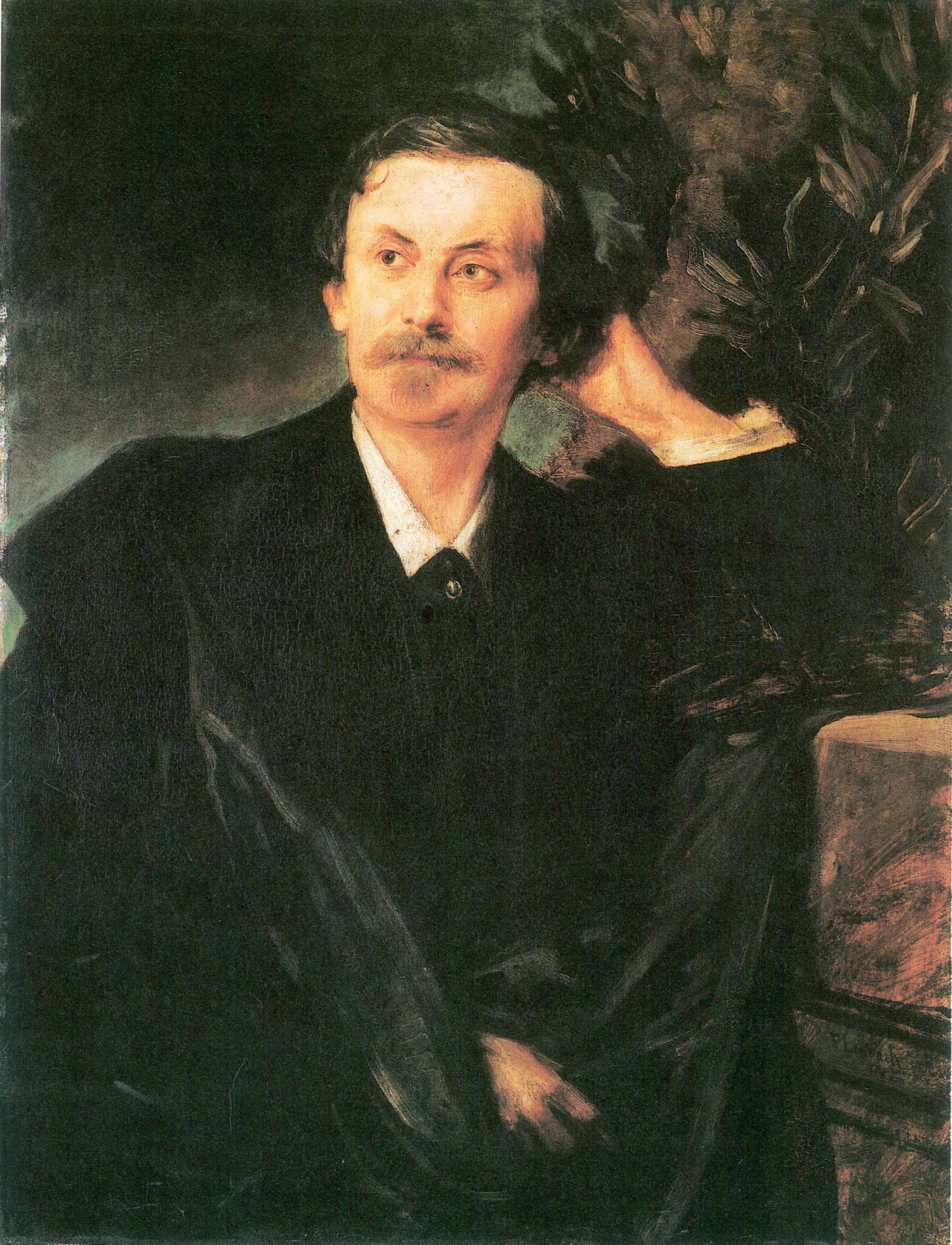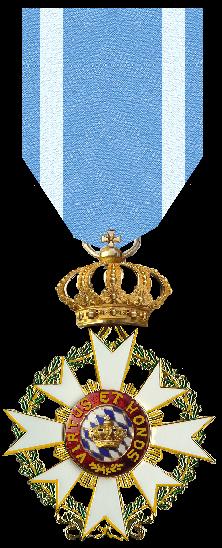|
Franz Von Lenbach
Franz Seraph Lenbach, after 1882, Ritter von Lenbach (13 December 1836 – 6 May 1904), was a German painter known primarily for his portraits of prominent personalities from the nobility, the arts, and industry. Because of his standing in society, he was often referred to as the "Malerfürst" (Painter Prince). Biography His father, who originally came from South Tyrol where the family name was spelled "Lempach", was a Master Mason for Schrobenhausen, where Lenbach was born. Lenbach completed his primary education at Landsberg in 1848, then attended a business school in Landshut. From 1851 to 1852, he was apprenticed to the sculptor Anselm Sickinger in Munich. At that time, his father died and he went home to help in the family business. He was only there a short time before beginning studies at the Augsburg University of Applied Sciences. While there, he drew and painted in his spare time, befriended Johann Baptist Hofner (1832–1913), the animal painter, and decided to bec ... [...More Info...] [...Related Items...] OR: [Wikipedia] [Google] [Baidu] |
Schrobenhausen
Schrobenhausen (; Central Bavarian: ''Schrobenhausn'') is a town in the district of Neuburg-Schrobenhausen in Bavaria, Germany. It is situated on the River Paar approx. south-west of Ingolstadt and north-east of Augsburg. The town hosts notable German arms manufacturers like MBDA and TDW. Schrobenhausen is also famous for its rich harvest of white asparagus in May/June. International relations Twin towns Schrobenhausen is twinned with * Thiers, France * Bridgnorth, England ''(since 1992)'' * Perg, Austria ''(since 1989)'' Famous citizens * Franz von Lenbach (1836-1904), painter, born in Schrobenhausen * Joseph Sattler (1867-1931), graphic artist, born in Schrobenhausen * Friedl Rinder (1905-2001), German chess master, born in Schrobenhausen * Hubert Fichte Hubert Fichte (; 21 March 1935, Perleberg, Province of Brandenburg – 8 March 1986) was a German novelist. Life Hubert Fichte was born on 21 March 1935 in Perleberg Hospital. A few weeks after his b ... [...More Info...] [...Related Items...] OR: [Wikipedia] [Google] [Baidu] |
Adolf Friedrich Von Schack
Adolf Friedrich, Graf von Schack (2 August 181514 April 1894) was a German poet, historian of literature and art collector. Background Schack was born at Brüsewitz near Schwerin. Having studied jurisprudence (1834–1838) at the universities of Bonn, Heidelberg and Berlin, he entered the Mecklenburg state service and was subsequently attached to the Kammergericht in Berlin. Tiring of official work, he resigned his appointment, and after travelling in Italy, Egypt, and Spain, was attached to the court of the grand duke of Oldenburg, whom he accompanied on a journey to the East. On his return he entered the Oldenburg government service, and in 1849 was sent as envoy to Berlin. In 1852 he retired from his diplomatic post, resided for a while on his estates in Mecklenburg and then travelled in Spain, where he studied Moorish history. In 1855, he settled at Munich, where he was made member of the academy of sciences, and here collected a splendid gallery of pictures, containi ... [...More Info...] [...Related Items...] OR: [Wikipedia] [Google] [Baidu] |
Ernst Schweninger
Ernst Schweninger (15 June 1850 – 13 January 1924) was a Germans, German physician and Naturopathy, naturopath who developed the Schweninger method, a reduction of obesity by the restriction of fluids in the diet. Biography He was born on 15 June 1850 in Freystadt, Upper Palatinate. He studied medicine at the Ludwig Maximilian University of Munich where he received his M.D. in 1870. His appointment to a chair (official), chair at University of Berlin, Berlin in 1884 against the wishes of the medical Faculty (university), faculty was largely due to his successful treatment of Otto von Bismarck for obesity. His method was a modification of the method developed by William Banting. He published ''Dem Andenken Bismarcks'' in 1899. He retired to private life in Munich in 1905. He died there on 13 January 1924. Schweninger rejected orthodox medicine and embraced naturopathy. He established the first nature cure hospital in Berlin. He was considered to have a doubtful reputation and w ... [...More Info...] [...Related Items...] OR: [Wikipedia] [Google] [Baidu] |
Pope Leo XIII
Pope Leo XIII ( it, Leone XIII; born Vincenzo Gioacchino Raffaele Luigi Pecci; 2 March 1810 – 20 July 1903) was the head of the Catholic Church from 20 February 1878 to his death in July 1903. Living until the age of 93, he was the second-oldest-serving pope, and the third-longest-lived pope in history, before Pope Benedict XVI as Pope emeritus, and had the fourth-longest reign of any, behind those of St. Peter, Pius IX (his immediate predecessor) and John Paul II. He is well known for his intellectualism and his attempts to define the position of the Catholic Church with regard to modern thinking. In his famous 1891 encyclical ''Rerum novarum'', Pope Leo outlined the rights of workers to a fair wage, safe working conditions, and the formation of trade unions, while affirming the rights of property and free enterprise, opposing both socialism and laissez-faire capitalism. With that encyclical, he became popularly titled as the "Social Pope" and the "Pope of the Workers", als ... [...More Info...] [...Related Items...] OR: [Wikipedia] [Google] [Baidu] |
Clara Schumann
Clara Josephine Schumann (; née Wieck; 13 September 1819 – 20 May 1896) was a German pianist, composer, and piano teacher. Regarded as one of the most distinguished pianists of the Romantic era, she exerted her influence over the course of a 61-year concert career, changing the format and repertoire of the piano recital by lessening the importance of purely virtuosic works. She also composed solo piano pieces, a piano concerto ( her Op. 7), chamber music, choral pieces, and songs. She grew up in Leipzig, where both her father Friedrich Wieck and her mother Mariane were pianists and piano teachers. In addition, her mother was a singer. Clara was a child prodigy, and was trained by her father. She began touring at age eleven, and was successful in Paris and Vienna, among other cities. She married the composer Robert Schumann, and the couple had eight children. Together, they encouraged Johannes Brahms and maintained a close relationship with him. She premiered many works by he ... [...More Info...] [...Related Items...] OR: [Wikipedia] [Google] [Baidu] |
Palazzo Borghese
Palazzo Borghese is a palace in Rome, Italy, the main seat of the Borghese family. It was nicknamed ''il Cembalo'' ("the harpsichord") due to its unusual trapezoidal groundplan; its narrowest facade faces the River Tiber. The entrance at the opposite end of the building, the "keyboard" of the Harpsichord, cembalo, faces onto the Fontanella di Borghese, with another in a great flanking facade to the Piazza Borghese that is extended by a slightly angled facade leading down Via Borghese towards the river. Both these entrances lead into a large courtyard on one side of which is a two level open arcade, with paired Doric and Ionic columns, that frames the garden beyond. The first floor of the palace is the seat of the Embassy of Spain in Italy since 1947. History The architectural historian Howard Hibbard has demonstrated that the nine-bay section of the palace on Piazza Fontanella Borghese was begun in 1560/61 for Monsignor Tommaso del Giglio, whose coat of arms or ''stemma'' remain ... [...More Info...] [...Related Items...] OR: [Wikipedia] [Google] [Baidu] |
Order Of Merit Of The Bavarian Crown
The Order of Merit of the Bavarian Crown (german: Verdienstorden der Bayerischen Krone) was an order of merit of the Kingdom of Bavaria established by King Maximilian Joseph I on 19 March 1808. The motto of the order is Virtus et Honos ('Courage and Honour'). The order was awarded in several grades: * Grand Cross * Grand Commander * Commander * Knight * Medal in Gold * Medal in Silver History King Maximilian I Joseph, founded the order to reward civil servants of the state of all classes and other foreigners who were deserving of recognition of the Kingdom of Bavaria. It was created as a civil counterpart to the Military Order of Max Joseph. Both the orders brought non-noble recipients in the collection of personal nobility with the title " Ritter von". The Order of Merit of the Bavarian crown was initially founded with three grades Grand Cross, Commander, and Knight. King Maximilian II added the grade of Grand Commander in 1855. For each grade there was a fixed number of mem ... [...More Info...] [...Related Items...] OR: [Wikipedia] [Google] [Baidu] |
Hans Makart
Hans Makart (28 May 1840 – 3 October 1884) was a 19th-century Austrian academic history painter, designer, and decorator. Makart was a prolific painter whose ideas significantly influenced the development of visual art in Austria-Hungary, Germany, and beyond. Life Makart was the son of a chamberlain at the Mirabell Palace, born in the former residence of the prince-archbishops of Salzburg, the city in which Mozart had been born. Initially, he received his training in painting at the Vienna Academy between 1850 and 1851 from Johann Fischbach. While in the Academy, German art was under the rule of a classicism, which was entirely intellectual and academic—clear and precise drawing, sculpturesque modelling, and pictorial erudition were esteemed above all. Makart, who was a poor draughtsman, but who had a passionate and sensual love of color, was impatient to escape the routine of art school drawing. For his fortune, he was found by his instructors to be devoid of all talent ... [...More Info...] [...Related Items...] OR: [Wikipedia] [Google] [Baidu] |
Maria Beccadelli Di Bologna
Maria Beccadelli di Bologna, Marchesa di Altavilla, Principessa di Camporeale (6 February 1848, Naples – 20 January 1929, Rome), married Princess Maria von Bülow, was the wife of Prince Bernhard von Bülow, the Chancellor of Germany. She was the daughter of Domenico Beccadelli di Bologna (1826–1863), Principe di Camporeale, and Laura, née Acton. Her mother was married in second marriage to the Italian prime minister Marco Minghetti and played a central role in Italian and German aristocracy. Maria began calling herself Marie after her marriage to the Prussian diplomat Karl August, Count of Dönhoff. They married on 15 May 1867 in Lugano, but were divorced in 1882 and the marriage annulled by the Pope in 1884. On 9 January 1886 in Vienna, she married Bernhard, Prince of Bülow, later Chancellor of the German Empire. She became a confidant of the Prussian Crown Princess Victoria Victoria, Crown Princess of Sweden, Duchess of Västergötland (Victoria Ingrid Alice Dés ... [...More Info...] [...Related Items...] OR: [Wikipedia] [Google] [Baidu] |
Panic Of 1873
The Panic of 1873 was a financial crisis that triggered an economic depression in Europe and North America that lasted from 1873 to 1877 or 1879 in France and in Britain. In Britain, the Panic started two decades of stagnation known as the " Long Depression" that weakened the country's economic leadership. In the United States, the Panic was known as the "Great Depression" until the events of 1929 and the early 1930s set a new standard. The Panic of 1873 and the subsequent depression had several underlying causes for which economic historians debate the relative importance. American inflation, rampant speculative investments (overwhelmingly in railroads), the demonetization of silver in Germany and the United States, ripples from economic dislocation in Europe resulting from the Franco-Prussian War (1870–1871), and major property losses in the Great Chicago Fire (1871) and the Great Boston Fire (1872) helped to place massive strain on bank reserves, which, in New ... [...More Info...] [...Related Items...] OR: [Wikipedia] [Google] [Baidu] |
Old Masters
In art history, "Old Master" (or "old master")Old Masters Department Christies.com. refers to any painter of skill who worked in Europe before about 1800, or a painting by such an artist. An "" is an original print (for example an or etching) made by an artist in the same period. T ... [...More Info...] [...Related Items...] OR: [Wikipedia] [Google] [Baidu] |



.jpg)




